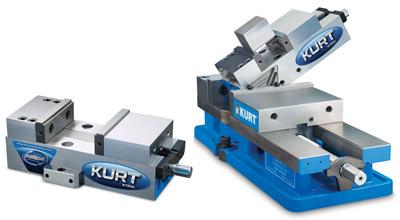
Kurt announces introduction of its new model KTR35 toolroom vise. Designed for use on small machine tables, this versatile vise mounts easily on all three sides to handle a wide range of workholding projects.
With an overall length of 10.125 inches weighing only 20 lbs, Kurt's Toolroom vise has a clamping force up to 4500 lbs. with in input torque of 45 ft. lbs. It has a maximum jaw opening of 3.81 inches on the bed and 4.06 inches in the step jaw.
Fully chip guarded, this vise can be mounted through the body or with optional outrigger toe clamps mounted to the outside of the body. All sides of the vise are precision ground for precision mounting on any of its three sides. Four cavities in the ends of the vise body make mounting with the optional toe clamps fast and easy.
For added versatility, Kurt's Toolroom vise can be used as a sine vise. It provides a quick and accurate method for holding a workpiece at an angle for machining or inspection. By mounting in a receiver vise, Kurt's Toolroom vise can be set at 30, 45 and 60 degree angles using the locating holes on the stationary side of the vise body. To utilize this feature, just remove the triangular shaped magnets and place the dowel pins in the proper holes to set any of the three angles desired.
Ideal for precision part clamping on most small machining centers, mills and grinders, the Kurt Toolroom vise has a solid, one piece 80,000 PSI ductile iron body with precision machined components. Like all Kurt vises, the robust design provides rugged strength, extra rigidity and long-term accuracy while absorbing machining vibration.
Contact Details
Related Glossary Terms
- centers
centers
Cone-shaped pins that support a workpiece by one or two ends during machining. The centers fit into holes drilled in the workpiece ends. Centers that turn with the workpiece are called “live” centers; those that do not are called “dead” centers.

